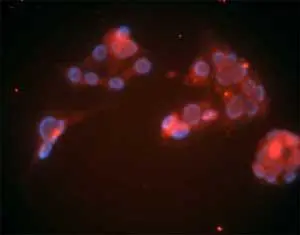
ICC: Human LDL in HepG2 cells fixed in methanol.
LDL Receptor antibody [15C8]
GTX16897
ApplicationsFlow Cytometry, ImmunoFluorescence, ImmunoPrecipitation, Western Blot, ELISA, ImmunoCytoChemistry, ImmunoHistoChemistry, ImmunoHistoChemistry Frozen
Product group Antibodies
ReactivityBovine, Human
TargetLDLR
Overview
- SupplierGeneTex
- Product NameLDL Receptor antibody [15C8]
- Delivery Days Customer9
- Application Supplier NoteFor ELISA: Use at a concentration of 0.5-1 microg/ml. For FACS: Use 5microg (undiluted) to label 10^6 clells - Incubate for 30min at 4oC. For ICC: Use at a dilution of 1-5 microg/ml. For IHC-Fr: Use at a dilution of 1-5 microg/ml. For IP: Use at a dilution of 1-2 microg/ml. For WB: Use at a dilution of 1-5 microg/ml. Predicted molecular weight: 160 kDa. Include 2mM Ca+2 with the antibody and avoid EDTA. Product GTX16897 has been reported to bind best to the unreduced LDL-R. Optimal dilutions/concentrations should be determined by the researcher.
- ApplicationsFlow Cytometry, ImmunoFluorescence, ImmunoPrecipitation, Western Blot, ELISA, ImmunoCytoChemistry, ImmunoHistoChemistry, ImmunoHistoChemistry Frozen
- CertificationResearch Use Only
- ClonalityMonoclonal
- Clone ID15C8
- Concentration0.1 mg/ml
- ConjugateUnconjugated
- Gene ID281276
- Target nameLDLR
- Target descriptionlow density lipoprotein receptor
- Target synonymsLDL receptor; low-density lipoprotein receptor
- HostMouse
- IsotypeIgG2a
- Scientific DescriptionThe low density lipoprotein receptor (LDLR) gene family consists of cell surface proteins involved in receptor-mediated endocytosis of specific ligands. Low density lipoprotein (LDL) is normally bound at the cell membrane and taken into the cell ending up in lysosomes where the protein is degraded and the cholesterol is made available for repression of microsomal enzyme 3-hydroxy-3-methylglutaryl coenzyme A (HMG CoA) reductase, the rate-limiting step in cholesterol synthesis. At the same time, a reciprocal stimulation of cholesterol ester synthesis takes place. Mutations in this gene cause the autosomal dominant disorder, familial hypercholesterolemia.
- ReactivityBovine, Human
- Storage Instruction2°C to 8°C
- UNSPSC12352203
